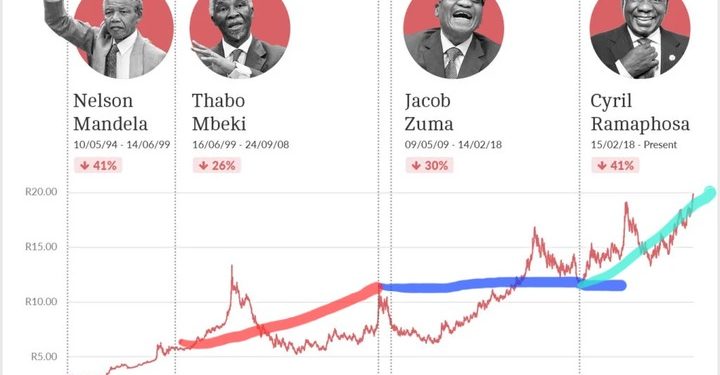In the world of politics, few figures have generated as much controversy and polarizing opinions as Jacob Zuma, the former President of South Africa. While his tenure was marked by a multitude of scandals and allegations of corruption, one aspect that often goes unnoticed is his relationship with the South African currency, the Rand. Despite the widespread PR against him and accusations of manipulating the economy, Zuma left the Rand virtually unchanged from when he took office in 2009 to his ousting from the presidency. It is a remarkable feat that deserves recognition.
During the early days of his presidency, Jacob Zuma faced a daunting task. The global financial crisis of 2008 had sent shockwaves through economies worldwide, and South Africa was not immune. The Rand had weakened considerably against major currencies, such as the US dollar, reaching a high of over R11 to the dollar. Despite these challenging circumstances, Zuma managed to maintain the Rand at this level throughout his presidency, leaving it unchanged when he ultimately left office.
It’s only Jacob Zuma who took the Rand at +R11 in 2009 during the beginning of his presidency,
And left it at +R11 during his ousting from presidency.
With all the PR against him and manipulation of the Rand.
But he left it where he took it.
Msholozi is and was a legend. pic.twitter.com/iigiLs2Pq2
— Sive ✨ (@SiveXaluva) June 1, 2023
Critics of Zuma often point to the numerous scandals and allegations of corruption that surrounded his presidency. They argue that his leadership was marked by mismanagement and the siphoning of state funds for personal gain. However, it is important to separate these controversies from the stability of the Rand. Regardless of one’s opinion on Zuma’s character, his ability to maintain the currency at a relatively stable level should not be overlooked.
Zuma’s presidency was marred by several high-profile incidents, including the 2015 firing of two finance ministers in less than a week, which led to a significant depreciation of the Rand. Nevertheless, the currency managed to recover and stabilize, thanks in part to the efforts of the South African Reserve Bank and other economic factors. Zuma may have been at the center of these controversies, but the Rand weathered the storm and remained resilient.
It is crucial to acknowledge that economic stability is a complex phenomenon influenced by a multitude of factors beyond the control of any single individual, even a president. While Zuma’s presidency was undoubtedly controversial, the relative stability of the Rand during his tenure suggests that the economy persevered despite the surrounding turmoil.
Jacob Zuma’s legacy will forever be a subject of heated debate and scrutiny. However, when it comes to the Rand, it is undeniable that he left it at a level comparable to where he found it. Whatever one’s opinions about Zuma’s leadership style and alleged misconduct, his ability to maintain the stability of the Rand deserves recognition. In the realm of economics, this accomplishment cannot be dismissed lightly. Love him or loathe him, Zuma’s impact on the Rand will be remembered as an intriguing aspect of his tumultuous presidency.






















